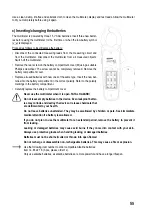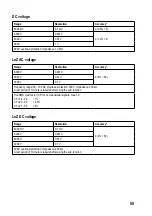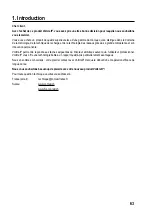
51
j) Measuring capacitance
Make sure that all objects that you wish to measure (including circuit components, circuits and
component parts) are disconnected and discharged.
Always pay attention to the polarity when using electrolytic ca-
pacitors.
• Turn the DMM on and select “CAP” mode. “nF” will appear on the display.
• Plug the red lead into the V terminal (K) and the black lead into the COM
terminal (I).
Due to the sensitive measuring input, the display may show a small
reading even with “open” test leads. Press the “REL” button to reset
the display to “0”. The REL function should only be used for small
capacitances.
• Connect the two test probes (red = positive, black = negative) to the object
that you want to measure (condenser). The capacitance will be shown on the
display after a few seconds. Wait until the display stabilises. This may take a
few seconds for capacitances greater than 40 µF.
2. “OL” (overload) indicates that the measuring range has been exceeded.
3. After measuring, remove the test leads from the measured object and turn the
multimeter off.
k) Non-contact AC voltage detection (NCV)
The voltage detector is only designed for quick tests and by no means replaces a contact bipolar
voltage test. This function must not be used to check that no voltage is present before carrying out
work.
The NCV function (non-contact voltage detection) enables the contactless detection of an AC voltage on electrical
conductors. The NCV sensor (A) is located on the top of the current clamp.
• Switch the DMM on. The “NCV” function is activated as soon as
the DMM is switched on.
• Place the NCV sensor as close as possible to an electrical con-
ductor.
• If an AC voltage is detected, the red NCV LED (D) will turn on.
• The highly sensitive NCV sensor may cause the diode to glow
when static electricity is present. This is normal and does not indi-
cate that the multimeter is faulty.
Always test the NCV function first on a known AC volt-
age source to avoid incorrect measurements. Incorrect
measurements may cause an electric shock. The inner
conductors are twisted in many cables. For this reason,
move the sensor a few centimetres along the cable to
ensure that you cover all parts of the inner conductors.
















































